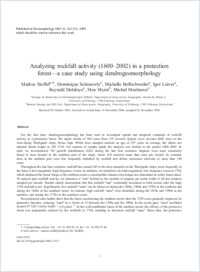Analyzing rockfall activity (1600–2002) in a protection forest—a case study using dendrogeomorphology
- Stoffel, Markus Geomorphology Research Unit, Department of Geosciences, University of Fribourg, Switzerland
- Schneuwly, Dominique Manuel Geomorphology Research Unit, Department of Geosciences, University of Fribourg, Switzerland
- Bollschweiler, Michelle Geomorphology Research Unit, Department of Geosciences, University of Fribourg, Switzerland
- Lièvre, Igor Geomorphology Research Unit, Department of Geosciences, University of Fribourg, Switzerland
- Delaloye, Reynald Geomorphology Research Unit, Department of Geosciences, University of Fribourg, Switzerland
- Myint, Moe Remote Sensing and GIS Unit, Department of Geosciences, University of Fribourg, Switzerland
- Monbaron, Michel Geomorphology Research Unit, Department of Geosciences, University of Fribourg, Switzerland
-
06.01.2005
Published in:
- Geomorphology. - 2005, vol. 68(3-4), p. 224
English
For the first time, dendrogeomorphology has been used to investigate spatial and temporal variations of rockfall activity in a protection forest. We report results of 564 cores from 135 severely injured Larix decidua Mill. trees on the west-facing Täschgufer slope, Swiss Alps. While trees sampled reached an age of 297 years on average, the oldest one attained breast height in AD 1318. For reasons of sample depth, the analysis was limited to the period 1600–2002. In total, we reconstructed 741 growth disturbances (GD) during the last four centuries. Impacts were most commonly found in trees located in the southern part of the slope, where GD recurred more than once per decade. In contrast, trees in the northern part were less frequently disturbed by rockfall and define recurrence intervals of more than 150 years.Throughout the last four centuries, rockfall has caused GD to the trees sampled on the Täschgufer slope, most frequently in the form of low magnitude–high frequency events. In addition, we identified one high magnitude–low frequency event in 1720, which displaced the forest fringe of the northern sector a considerable distance downslope and eliminated an entire forest stand. To analyze past rockfall activity, we introduce a “rate” defined as the number of impacts per meter width of all tree surfaces sampled per decade. Results clearly demonstrate that this rockfall “rate” continually decreased in both sectors after the large 1720 rockfall event. Significantly low rockfall “rates” can be observed during the 1850s, 1960s and 1970s in the northern and during the 1820s in the southern sector. In contrast, high rockfall “rates” were identified during the 1870s and 1990s in the northern, and during the 1770s in the southern sector.Reconstructed data further show that the forest recolonizing the southern sector after the 1720 event gradually improved its protective function, reducing “rates” by a factor of 13 between the 1740s and the 1990s. In the recent past, “rates” oscillated around 0.7 GD 1 meter width⁻¹ (10 years)⁻¹. In the well-established forest of the northern sector, the efficacy of the protective forest was temporarily reduced by the rockfalls in 1720, resulting in increased rockfall “rates”. Since then, the protective function of the forest stand has increased again, resulting in a rate of 0.4 GD 1 m width⁻¹ (10 years)⁻¹ during the late 20th century.
- Faculty
- Faculté des sciences et de médecine
- Department
- Département de Géosciences
- Language
-
- English
- Classification
- Geology
- License
- License undefined
- Identifiers
-
- RERO DOC 5032
- DOI 10.1016/j.geomorph.2004.11.017
- Persistent URL
- https://folia.unifr.ch/unifr/documents/299771
Statistics
Document views: 178
File downloads:
- 1_monbaron_ara.pdf: 231
